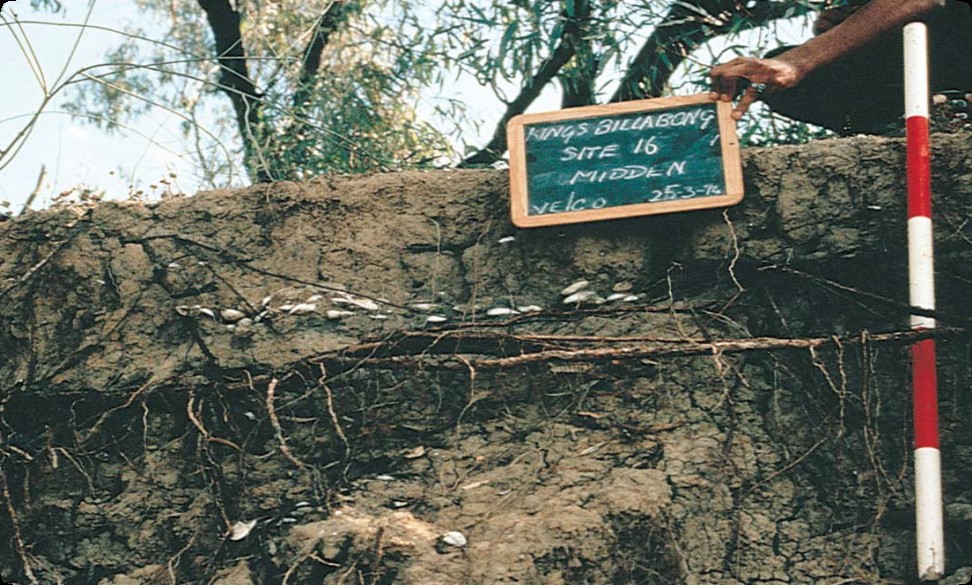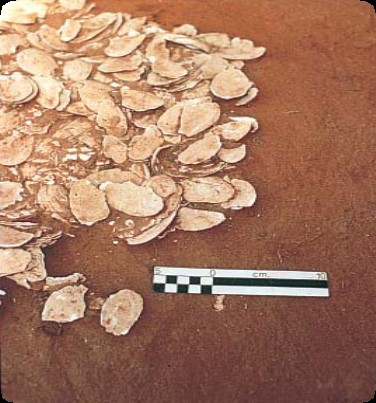Characteristics
- concentrations of freshwater mussel shells. Size can vary greatly, from as little as 1 metre long to 1000 metres long, and in thickness from only 50 mm to as much as 1 metre
- shells are often in a layer of soil or sand that is unusually dark, or even black
- charcoal, ash, burnt clay and burnt stone may be visible within the shell layers
- shells and bones, if these are present, may show signs of having been burnt
- stone tools and Ancestral Remains are sometimes present
What are middens?
Freshwater middens are accumulations of shell produced by Aboriginal people collecting, cooking and eating freshwater shellfish. Middens usually occur as fairly thin layers or small patches of shell. The shells usually come from both the freshwater mussel (Velesunio ambiguus) and river mussel (Alathyria jacksoni).
The shells may be the remains of just one meal or hundreds of meals eaten over thousands of years.
Shell middens often contain evidence of cooking such as charcoal, ash, fire-stones, burnt earth or burnt clay. Sometimes they also contain animal bones, fish bones, stone tools and Aboriginal burials.
Where are they found?
Freshwater shell middens are found along river banks and flood plains, near swamps and lakes, and in sand dunes. They are sometimes found in dry areas, where fresh water was once present.
Freshwater mussel shells may also be found in Aboriginal oven mounds, but usually only in small quantities. Middens may be visible as scatters of broken mussel shell, exposed along vehicle tracks. If you look closely, you may find mussel shells buried in the surrounding soil. Middens are also commonly visible as scatters of mussel shell eroding down the slopes of dunes. Again, the scatters can usually be traced up the dune to the buried shell layer.
Shell fragments in the upcast from rabbit burrows in dunes may also indicate a midden.
What caused Aboriginal middens?
Freshwater shell middens were produced by Aboriginal people collecting, cooking and eating freshwater mussels. Early European settlers observed Aboriginal people, usually women and children, collecting shellfish from rivers, lakes and swamps.
Shellfish collecting was relatively easy. Depending on the season, one person could collect up to 200 shellfish in an hour. Once collected, the shellfish were usually partially roasted on an open fire, which caused the two halves of the shell to separate, so the inside could be eaten.
Some middens may have been produced by one meal. Others contain accumulated remains of many meals that occurred over hundreds, or even thousands, of years. Some middens contain bones of fish and other animals and stone tools, showing that fishing, hunting and stone working may also have occurred while these places were occupied. Other middens contain almost nothing except shells.
Ancestral Remains are sometimes found in or near shell middens, but it is not clear whether these burials took place while the place was occupied, or whether the burials being in the same place as middens is a coincidence. In some situations shellfish have been deliberately buried with the interred person as ‘grave goods’.
What else causes clusters of shells?
Freshwater mussels are sometimes preserved naturally as layers within soil or sand, particularly in, or near lakes. Shells that occur in these natural layers are often still joined at the hinge, unlike those found in Aboriginal middens.
Natural shell accumulations are likely to contain shellfish of many different ages and sizes, while Aboriginal middens generally contain fairly mature mussels of roughly the same size. Natural shell accumulations are also unlikely to have the dark sediment, evidence of burning, bones or stone tools that occur in Aboriginal middens. Native animals that eat mussels, such as water rats, may also build concentrations of shells, but these are likely to be small, and again lack dark sediment or signs of burning.
How did Aboriginal people use freshwater mussels?
Aboriginal people probably began exploiting freshwater mussels soon after their arrival in Australia. Some of the oldest cultural places in Victoria are freshwater shell middens. Shellfish could be collected easily and quickly, but the small amount of meat available from each shellfish, and the relatively low energy value of the meat, meant that it took a lot of effort to gather enough mussels to provide much nourishment.
The main role of freshwater mussels in the Aboriginal economy was probably to supplement a diet based around other animal and plant foods. Mussels may also have been used as a reserve supply of food during the hot and dry months, when other food was scarce.
Freshwater mussels can survive buried in damp ground for up to two years. Early European settlers observed Aboriginal people digging for mussels in the mud of dry creek beds. An Aboriginal store of more than 360 mussels, neatly sacked and buried about 1 m deep, has been found. Presumably the mussels were stored for use during a harsh period when other food was in short supply.
Because mussels can tolerate dry conditions for long periods, they can be moved far from their original source. Some Aboriginal people may have traded freshwater mussels to other groups living in areas where there were no shellfish. The shells of mussels were also traded and used as tools, either to make fish hooks or to scrape animal hides and wood.
Why are middens important?
Freshwater shell middens provide valuable information about past Aboriginal economy and land use. They are one of the few sources of information about Aboriginal use of lakes, rivers and swamps. Although mussel shells are fragile, they often survive longer than animal bones and plant remains. Studies of the shells themselves can tell us a lot.
In a similar fashion to trees, mussels regularly add growth rings to their shells. The shape and size of these rings vary according to changes in the local climate, and so can therefore provide a record of events such as floods and droughts. By looking at the shells in a midden we can learn about the environment that existed when Aboriginal people collected the mussels.
We can also compare the growth rings on different shells to see whether all the shells in the midden were collected at the same time, or at a number of different times. Mussel shells can also be radiocarbon dated so that we can tell during which time period Aboriginal people occupied an area.
Shell middens provide Aboriginal people today with an important link to their culture and their past. Middens that contain Ancestral Remains are particularly significant.
Threats to Aboriginal freshwater shell middens
Although mussel shells survive well while buried in sand or soil, once exposed to the air they rapidly deteriorate. As many middens are located on the edges of lakes and rivers, water often exposes and, over time, destroys these places.
Middens in sand dunes are sometimes disturbed by mining, rabbit burrowing and wind erosion.
First Peoples - State Relations records all freshwater shell middens, so that we will have a permanent photographic and written record of this important part of the heritage of all Australians. Some particularly good examples of middens may require active conservation, so that they can be preserved for future generations.
Are Aboriginal freshwater middens protected?
All Aboriginal cultural places in Victoria are protected by law. Aboriginal artefacts are also protected.
It is against the law to disturb or destroy an Aboriginal place. Artefacts should not be removed from site.
What to do if you find a midden
- do not disturb the place or remove any material
- check whether the shell cluster has the typical characteristics of an Aboriginal freshwater shell midden
- if it does, record its location and write a brief description of its condition
- note whether it is under threat of disturbance.
Please help to preserve Aboriginal cultural places by reporting their presence to First Peoples - State Relations.
Updated



